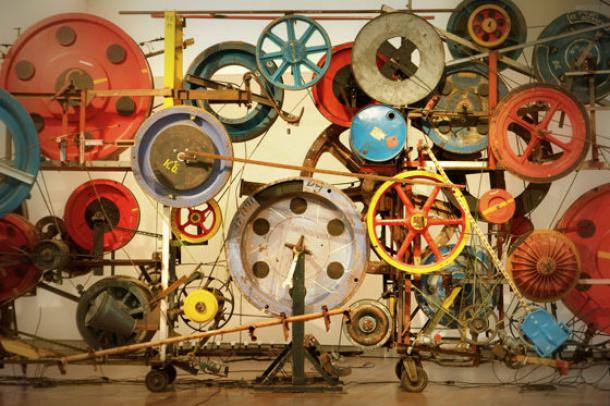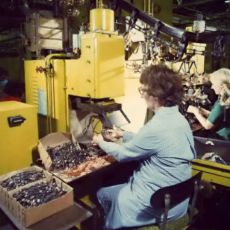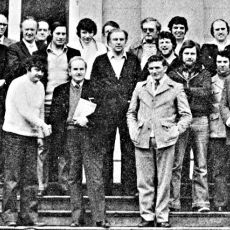Yugoslavia’s self-management
Sixty years ago, the Federal Assembly of Yugoslavia inaugurated workers' self-management. The Yugoslav experiment is a gold mine of experiences; it was the most comprehensive long-term attempt to establish popular self-government in history. As such, its analysis is a very useful starting point for the future: as it is useful to learn about the positive aspects of this experience, it is also good to learn from Yugoslav mistakes and limitations.Sixty years ago, the Federal Assembly of Yugoslavia inaugurated workers' self-management. The Yugoslav experiment is a gold mine of experiences. As it is useful to learn about the positive aspects of this experience, it is also good to learn from Yugoslav mistakes and limitations.
Professor Stipe Šuvar humorously depicted the Yugoslav experience, in accordance with its underdeveloped material and cultural reality, as a form of “shephards’ self-government”. About 75% of the Yugoslav population were peasants prior to the Second World War. A leading communist and perhaps the single most important architect of the Yugoslav system of “self-government”, Edvard Kardelj, noted that Yugoslav pre-war electricity production was 59 times below the European average.
In terms of the weakness of “subjective” forces, the Communist Party of Yugoslavia was illegal and underground for more than twenty years, since 1920 to 1945. This reinforced undemocratic, hyper-centralist and hierarchical patterns and precluded the open development of the Yugoslav labour movement. The population did not have sufficient experience in the struggle for self-emancipation. It lacked the necessary self-confidence, class consciousness, the required educational level and democratic political culture. The Stalinist practices of the Communist Party, particularly before its split with Stalin, certainly didn’t help in this respect.
THE PATH TO INNOVATION
Some have identified the origins of Yugoslav participatory development in the anti-fascist committees during the war itself. These were formed in 1941 as organs of dual power and an expression of an autonomous anti-fascist initiative in Yugoslavia. Leading communists like Kardelj and Moša Pijade later reinterpreted these anti-fascist committees as the first nascent forms of the Yugoslav independent, non-Stalinist course.
In reality, it was only after the historic split with the Soviet Union in 1948 that a truly anti-Stalinist alternative road began to be paved. The Yugoslav leaders had to legitimise their shift in ideological terms. It appears that they looked back to earlier attempts to institute self-management (like the Paris Commune), as well as Lenin’s “State and Revolution” and the like. This period of retrospection, introspection and innovation led to the abandonment of the forced collectivisation programme, and culminated in the first laws (in 1950) which led to the socialisation of most nationalised industries. This was preceded by the establishment of the first workers’ council in 1949 in the Croatian city of Solin.
In addition to workers’ councils, attempts to institute a dose of self-management extended to local committees, and also partially to administrative committees in educational, cultural, scientific, health and other social institutions. This isn’t the place to discuss all these institutional forms in detail, but a few words on so-called “workers’ self-management” are in order. Workers’ councils consisted of workers’ delegates, but they did not exist on their own. They were supposed to co-manage with specialists and company managers, who were – in the normative division of labour – supposed to execute the decisions of the workers’ council, and to deal with day-to-day functioning of the company.
In these new conditions, Yugoslavia began its reconstruction and soon achieved a fantastic level of growth and development, a transformation from a poor, rural semi-colony into a strongly independent, medium-developed industrialised country (although with acute regional inequalities and disparities). Still, a massive increase in the living standard was achieved in the fields like education, health care, workers’ rights and social security, etc. Social welfare, socialised health care and socialised housing were on a world-class level. In fact, Yugoslavia had the highest level of workers’ rights in the world, though of course not the highest standard of living.
It is very important to note that Yugoslav development illustrates the possibility of achieving a very high level of productivity in a post-capitalist system. For a time in the 1960s, Yugoslavia had the highest level of GDP growth after Japan. This is obviously a very good argument against those who claim that industrial democracy or workers’ participation are somehow “ineffective”.
LIMITATIONS ON DEMOCRACY
I already mentioned some objective and subjective factors which preclude a more consistent self-managing system. Now I will consider them in more concrete terms.
Firstly, a relatively participatory, democratic economy on the company level functioned in a wider authoritarian system of political monopoly. This was the fundamental contradiction of the Yugoslav system, and the reason why the demand for more direct political democratisation was central. However, this class conceptualisation of democratisation was eventually replaced by a nationalist, bureaucratic decentralisation which did not question the position of the political and bureaucratic elites. Despite some dubious attempts, the party and the state machinery weren’t self-liquidating, and there was no other force in society which was allowed or able to do this job for them.
Secondly, and connected with this, social inventions and economic democratisation were envisaged and directed from above, not by a direct-democratic movement from below. The unfortunate truth is that – considering the low level of class consciousness and popular self-organisation – nobody else but the Communist Party could have done it. Paternalistic implications of this made the development of a self-governing democratic consciousness more difficult. A very important aspect of this problem was the fact that trade unions did not have an independent, combative activist role, but were conceived as a kind of “transmission belt” for the party and the regime. There was actually no serious socialist opposition and pluralism in political, social and cultural life, no (conventionally) free media – let alone participatory democratic forms of media production and regulation. A concomitant problem was that workers very often weren’t aware of – or for other reasons failed to use – those rights they did have, so that for instance one study of local committee decision-making found out that about 98% of the proposals put forward by the bureaucracy were accepted by so-called “self-managers”. Similarly, citizens had a right of recall of elected officials, but they never used it!
Thirdly, the underdeveloped character of objective and subjective productive forces strenghtened the position of bureaucrats and directors in companies, who de facto led companies instead of workers’ councils, which only had a controlling function. This state of affairs was reinforced by a situation in which specialists were more closely connected with stable managerial layers – often strongly supported by the party – and these specialists were not really controlled by the rotating, often changing workers’ councils. Thus workers’ councils were rarely in the position to suggest alternative economic plans in opposition to the plans put forward by the managers and their specialists. Concomitanly, state bureaucracy and the managerial layers continued to hold a monopoly over extended reproduction, so that the rate of exploitation actually grew in the 70s and 80s. In his research, Professor Josip Obradovic concluded (through a set of empirical indicators) that the power and influence of the managerial layer was 200 times greater than that of the workers in production. This power disparity became even more acute on higher levels of decision-making. The vast majority of representatives in the national parliaments and the Federal Assembly were party members, under strict guidance from the top echelon in the party bureaucracy. Company managers and local politicians, even if not always formally party members, were also manipulated behind the scenes by the Communist Party machinery, even though the party was supposed to be self-abolish as an administrative body, and was renamed as the “League of Communists” in 1952. It retained its leading position in society, and an underlying homogeneity of bureaucratic interests, while the masses remained largely disorganised, fragmented and manipulated through the supposedly “self-governing” (but in reality bureaucratically controlled) structures of economic, social and political decision-making.
Fourthly, a rural, patriarchal mentality also limited the development of a democratic political culture. Partly as a manifestation of this, student and pupil participation in decision-making was never seriously contemplated for elementary and secondary schools. It was foolish to expect that pupils, who haven’t been educated in the school of democracy, would somehow become self-governing individuals after being reared for obedience for many years in the most formative period of their personal and social development.
Fifth, a great part of the population was effectively excluded from self-managing processes. This was clearly the case with the rural population. The sole exception was a very basic kind of cooperative decision-making in local village committees. Furthermore, the army and the party were also excluded from democratic processes, or even any kind of democratic control from below. Somewhat paradoxically, the hierarchical nature of the party’s internal relations – and of its relationship towards society – discredited the idea of self-government in the eyes of the population. It also made it easier for bureaucrats and nationalists like Milosevich to monopolise these institutions.
Insufficient attention (partly understandable considering the rush to accumulate wealth and raise the basic material standard of living) was also given to the creation of a new humanist culture, and to the creation of cultural self-management. I am referring both to “culture” as it is commonly understood and especially in the broader Gramscian sense of “integrated culture” and civiltá. Culture is central to the break-up of the rigid class division of labour in two fundamental ways. Firstly, because it raises workers’ and citizens’ educational level, needs and aspirations. Secondly, because self-government is unsustainable unless it extends to the democratic reproduction of a new socialist, self-governing cultural hegemony.
However, as nationalist concerns came to the fore, the burden of violent past came back with a vengeance. By fighting fascism through fascist methods (as especially evidenced in the post-war mass court martials and executions), and Stalinism through Stalinist methods (e.g. the Goli otok concentration camp), the new Yugoslav regime created hidden, underground (and of course initially minoritarian) subcultures of hatred and distrust. This nationalist and pro-capitalist backlash increasingly eroded the position of humanistic values in society.
An additional set of problems had to do with the issue of the market. On the one hand, companies often lacked market autonomy. There was a lot of paternalistic political control over companies, and the government was in the risky habit of socialising losses made by the unproductive companies. This meant that the workers often didn’t directly depend on their “self-managing” decisions, which eroded their responsibility and consequently their intrinsic motivation and interest in helping themselves – i.e. it diminished their commitment to freedom through self-government. On the other hand, speedy marketisation and lack of cohesion between different “self-managing” economic units (especially since the late 1960s) led to new inequalities, a huge foreign debt through imprudent loans, inflation, shortages of goods, of housing etc. Market principles also encouraged self-interest and competition between firms, consumerism and spread of Western economic, political and ideological influence, in addition to destabilising IMF blackmails. Combined with the growing problem of “xenomania” (in the form of increasingly uncritical adoration and emulation of the developed capitalist West), these economic difficulties strongly restated the problems of “socialism in one country”. Concerning the market debate, some authors (like Catherine Samary) have charted out the possibility that a “higher synthesis” of planning and initiative could be achieved through decentralised, participatory democratic planning. Yugoslavia even established some forms of decentralised planning through the continual economic communication and co-planning between (professional managerial) delegates of economic and social organisations, which enabled quicker and less damaging supply and demand information gathering than the market could ever provide. Such and other decentralised forms of planning could offer many of the advantages that the market system holds over bureaucratic, central planning, but minus the frequent slaps on the face that the economy and society are given by its “invisible hand”.
This third road between central planning and conventional “market socialism” remained only an abstract possibility, as did the prospect for democratic socialism in general. Genuine democratisation through social struggle from below wasn’t too realistic considering the absence of organised progressive political and trade union opposition to the regime and the existing system. The Yugoslav communists and socialists failed to valorise that internal systemic dynamism through political, social and cultural pluralism is the crucial precondition for progress and long-term sustainability of the new post-capitalist order. The practice of genuine participatory democratic pluralism is actually the most consonant path for achieving egalitarian social development.
To sum up, the Yugoslav “self-managing” experiment was neither sufficiently integral nor sufficiently organically tied to the masses. Still, it was the most comprehensive long-term attempt to establish popular self-government in history. As such, its analysis is a very useful starting point for the future.
Notes






Comments
Post new comment